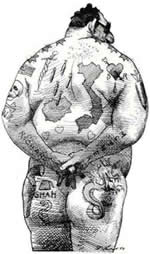
Why Did The New York Times Kill This Image of Henry Kissinger?
(Not for His Naked Butt Cheeks!)
By Steve Brown – AlterNet (9 Mar 2009)

Why Did The New York Times Kill This Image of Henry Kissinger?
(Not for His Naked Butt Cheeks!)
By Steve Brown – AlterNet (9 Mar 2009)
The Bitcoin Whales: 1,000 People Who Own 40 Percent of the Market
Bloomberg | 08 December 2017
With a shrug…
The New Great Game moves from Asia-Pacific to Indo-Pacific
Asia Times | 07 Decem…

SOLARI HERO OF THE YEAR
To continue reading the 2014 Annual Wrap Up subscribe to The Solari Report here. Subscribers can log in to finish reading here.
For all the years that I have enjoye…

I believe one of the goals of the swine flu vaccine is depopulation. Perhaps it is the goal of a swine flu epidemic as well, whether bio-warfare or hype around a flu season.
These days, I keep rememb…

8 Amazing Maps of Food in America
Wired
WIRED partnered with Food Network and crunched 49,733 recipes and 906,539 comments…
Why Your Supermarket Only Sells 5 Kinds of Apples
Mother Jones | April 20…

(Photo Credit: AP Photo/Mikhail Klimentyev)
By Vladimir Isachenkov
Russia has ratcheted up pressure on Ukraine, with President Vladimir Putin saying in a letter released Thursday that it only will …

[CAF Note: I am republishing this post – originally published in March 2009 of a taxonomy made in the 1990’s – as a subscriber asked for guidance on the important areas of data collection for ma…
Comments are closed.
To help you live a free and inspired life. This includes building wealth in ways that build real wealth in the wider economy. We believe that personal and family wealth is a critical ingredient of both individual freedom and community. health and well-being.
Nothing on The Solari Report should be taken as individual investment advice. Anyone seeking investment advice for his or her personal financial situation is advised to seek out a qualified advisor or advisors and provide as much information as possible to the advisor in order that such advisor can take into account all relevant circumstances, objectives, and risks before rendering an opinion as to the appropriate investment strategy.
No products in the cart.
Hello. Your site is really cool. I would love to have my website as good as yours.
I beg to differ on the explanation. Most people will say carrot when asked for a vegetable name.
Words appeal to our conscious minds, images to our subconscious. A single image, if contrasting enough against our usual thoughts of a subject, can provide an alternate lens/perspective through which to view that subject. Sometimes whether we want to use it or not. I wouldn’t say our subconscious minds run the show, but they draw up our first impressions and often determine what we focus on in the first place.
I look at the subconscious mind as activity that hasn’t passed through the thresh-hold of awareness. I’ll post a trick I found on youtube that demonstrates how these not-quite thoughts can guide our thinking. I think the real power of imagery is that our subconscious minds do not differentiate well if at all between false and real images. I believe that to our subconscious minds, everything we see is valid. But I believe in evolution so my main supporting argument for that would leave us at an impass.
So here is that little game/trick. After following a couple instructions, you’ll be asked to make a choice, please answer out loud with the first response that comes to mind.
Point at each number while reading them out loud.
2
2 2
2 2
2 2
2 2
2 2
222
Read these numbers out loud
14
18
24
Name a vegetable
Answer below has each word backwards:
tsoM elpoep esoohc torrac esuaceb eht epahs fo eht tsrif srebmun selbmeser eno dna eht rettal
srebmun era nommoc starac rof yrlewej.